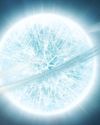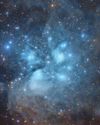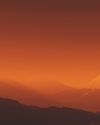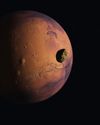HUNTING FOR INTERSTELLAR PLANETS
All About Space UK
|Issue 144
Space is suspected to be filled with worlds wandering alone without a star, but could such loners ever shelter life?

In the past few decades, we’ve grown used to the idea of exoplanets – distant worlds orbiting stars in alien solar systems. Some of these planets are very different from our own – scorched gas giants skimming the surfaces of their stars or frozen balls of ice larger than Earth. But perhaps the strangest exoplanets are those that drift alone through the darkness of interstellar space, far from the heat and light of any star. Only a handful of these objects are known, but many billions of them could be scattered across our galaxy – estimates vary from at least a couple for each of the Milky Way’s 200-billion-plus stars, up to an astonishing 100,000.
Astronomers call these mysterious worlds interstellar or ‘rogue’ planets, but in order to understand them, we first need to find them and learn more about their characteristics – and that’s a challenge in itself. The vast majority of exoplanets discovered so far have been detected through their influence on their parent stars – either the tug of their gravity on the star’s path through space or slight dips in the star’s brightness as a planet transits in front of its star as seen from Earth. But for interstellar planets, neither of these techniques work. The other obvious route of observing them through their own light and other radiation is also caught in a catch-22 situation: while the light of exoplanets is often drowned by that of the stars they orbit, most are only visible at all thanks to reflected starlight. Earth-like interstellar planets – relatively tiny balls of rock floating far from any stars – are so small, cold and faint as to be almost impossible to detect. The only exception might be if they wander by chance in front of a more distant star and create a microlensing event, where the starlight is bent.
このストーリーは、All About Space UK の Issue 144 版からのものです。
Magzter GOLD を購読すると、厳選された何千ものプレミアム記事や、10,000 以上の雑誌や新聞にアクセスできます。
すでに購読者ですか? サインイン
All About Space UK からのその他のストーリー

All About Space UK
MYSTERIES OF THE UNI WHERE ARE ALL THE SPIRAL GALAXIES?
There are far fewer spiral galaxies than elliptical ones in the Supergalactic Plane, and scientists are keen to discover why
7 mins
Issue 161

All About Space UK
ZOMBIE STARS
+10 OTHER TERRIFYING SPACE OBJECTS
8 mins
Issue 161

All About Space UK
HOW TO BEAT LIGHT POLLUTION
Thought it was impossible to observe the wonders of the night sky from towns and cities? Think again. Follow our tips and tricks on successfully observing through sky glow
2 mins
Issue 161

All About Space UK
15 STUNNING STAR CLUSTERS
These beautiful stellar groupings are spattered across the cosmos
8 mins
Issue 161

All About Space UK
Eileen Collins "It was a difficult mission...we were the first to see Mir"
Having served as both the first female pilot and first female commander of NASA's Space Shuttle, Collins boosted the involvement of women in space exploration to a whole new level
9 mins
Issue 161

All About Space UK
MARS LEAKS FASTER WHEN IT'S CLOSER TO THE SUN
The Red Planet has lost enough water to space to form a global ocean hundreds of kilometres deep
2 mins
Issue 161

All About Space UK
FUTURE TECH KANKOH-MARU
This ambitious reusable spacecraft will be capable of taking 50 people to and from orbit
2 mins
Issue 161

All About Space UK
THE FINAL FRONTIER
Beyond the reach of the Sun is a fascinating region of the cosmos that were only just beginning to explore
8 mins
Issue 161

All About Space UK
A long-lost moon could explain Mars' weird shape and extreme terrain
A long-lost moon could explain why Mars is so different from the other rocky planets in the Solar System. Today Mars has two tiny moons.
2 mins
Issue 161

All About Space UK
A sprinkling of cosmic dust may have helped kick-start life on Earth
Cosmic dust may have helped kick-start life on Earth. New findings challenge a widely held assumption that this wasn't a plausible explanation.
3 mins
Issue 161
Translate
Change font size

